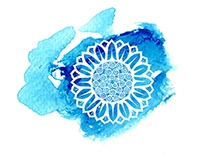I have never actually met Joan Wisdom, but I have had the pleasure of becoming acquainted with her through her paintings that she produced while she was a patient at Netherne Mental Hospital in Surrey England in the 1960’s under the facilitation of Edward Adamson who was appointed in 1946 by Dr Eric Cunningham Dax to manage the Art class that Dax Initially set up to help him analyze the mental health of the patients, specifically in the area of Schizophrenia. Following Dax’s departure for Australia in 1951 Adamson continued to run the Art Studio at Netherne until his retirement in 1981. He operated in a ‘hands off’ approach, allowing the patients to produce whatever they liked. It is this freedom of expression that makes the Adamson Collection of works so unique and important in the history of Art Therapy. Edward Adamson produced his book ‘Art as Healing’ which has been a source of reference and learning for Art Therapists since its release in 1984.
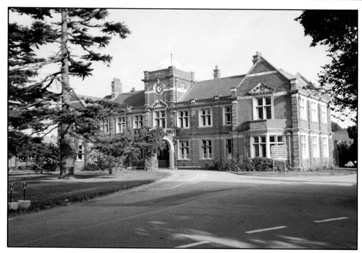

Nethern Mental Hospital and Edward Adamson (1911-1996)
Edward Adamson collected approximately 6000 artworks
produced by patients at Netherne during his time there which is now held at the
Wellcome Trust on behalf of The Adamson Collection Trust that is run by David O’Flynn.
Originally there were over 100,000 artworks produced by the patients at Netherne, however, sadly, the remainder have
become lost, most likely destroyed during the Closure of Netherne Hospital in 1994.
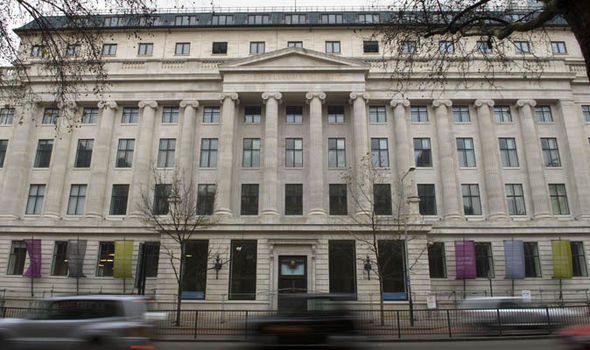


The Wellcome Trust 183 and 215 Euston Road, London W1
and Lambeth Hospital
I have been privileged enough to have been able to view a great number of the works that are held at the Wellcome Trust and at Lambeth Hospital. I was drawn to the collection I think by the sheer volume and diversity of work it held, and by the fact that these works were true and free creations by the patients, not guided or analyzed by doctors or Psychiatrists. I had no particular brief in mind when I started looking at the work, I just wanted to see as much as possible and absorb it as a whole.
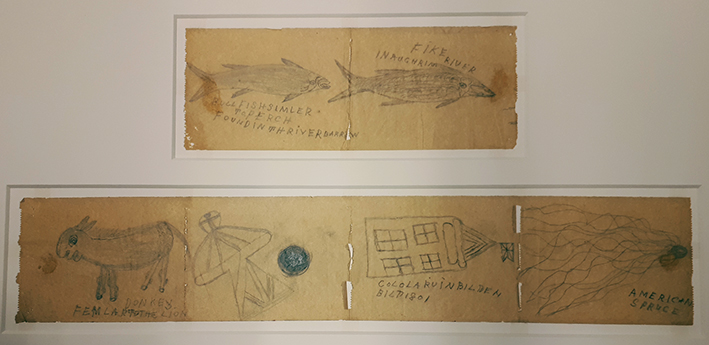
J J Beegan
When Adamson had just set up his studio at Netherne, he was given some artwork drawn on toilet paper by
a
patient; J J Beegan. It was this gift that was to become the inspiration for the Adamson Collection.
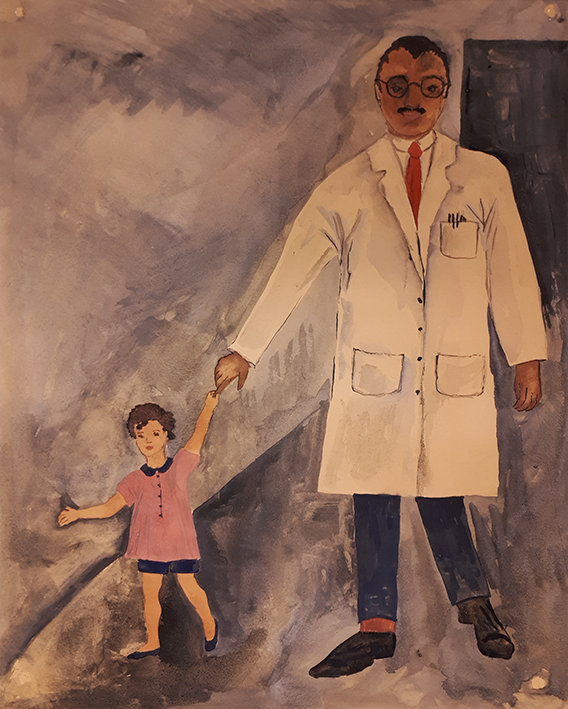
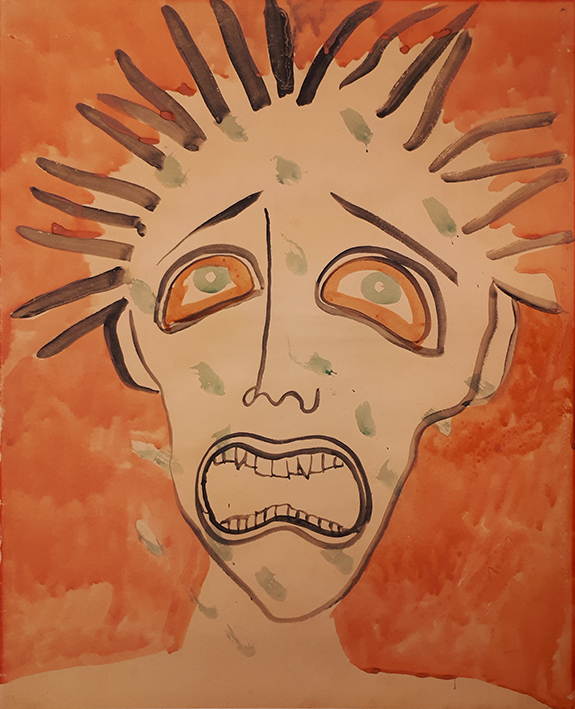
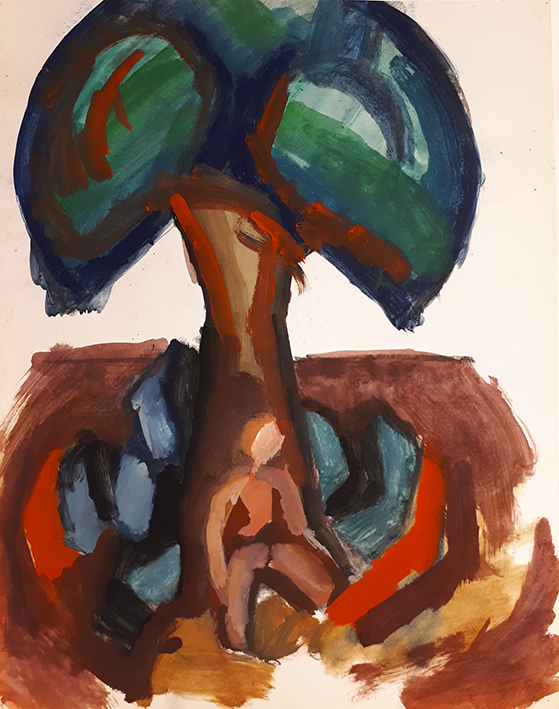
Thea Heart, Mary Bishop and Lowe Watson
Much of the collection at the time of writing has not been catalogued, which actually ended up playing to my advantage. Normally when ordering works to view in the Rare Materials Room at the Wellcome Trust you can order the artworks signally, up to a maximum of 20 at one time. On looking down the list of works in the collection I realised that the uncatalogued works were listed as folders of works by the Artist’s name, or as folders containing a number of works by unknown Artists. It was through this process of being able to order so much of the work in bulk that I discovered so many of the artists, and got to see so much of their work. In particular I got to view artwork by Joan Wisdom and fell in love with her work!
The Institutionalized Patient
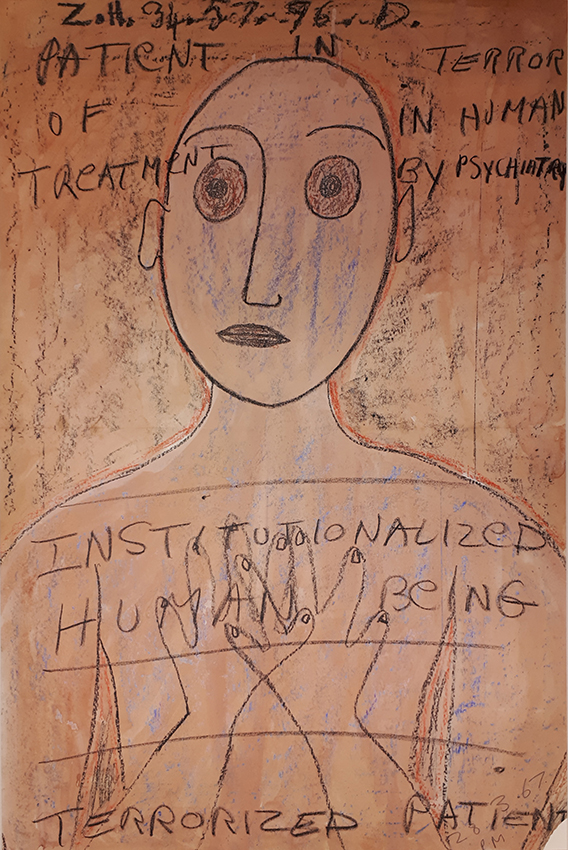
Joan Wisdom's work is very distinctive and not only accomplished in
technique but in raw emotional expression. It did not take long before I realised
that one of the poster images that had been used to publicise The Adamson
Collection that was attributed to Martin Birch, had to be by Joan Wisdom. Not
only was the style and writing the same as Joan’s work, it had her Hospital
Number Z.H.34.57.96.D emblazoned across it. Wellcome has now re-attributed the
work to Joan Wisdom and has scheduled her work as next in line for cataloguing.
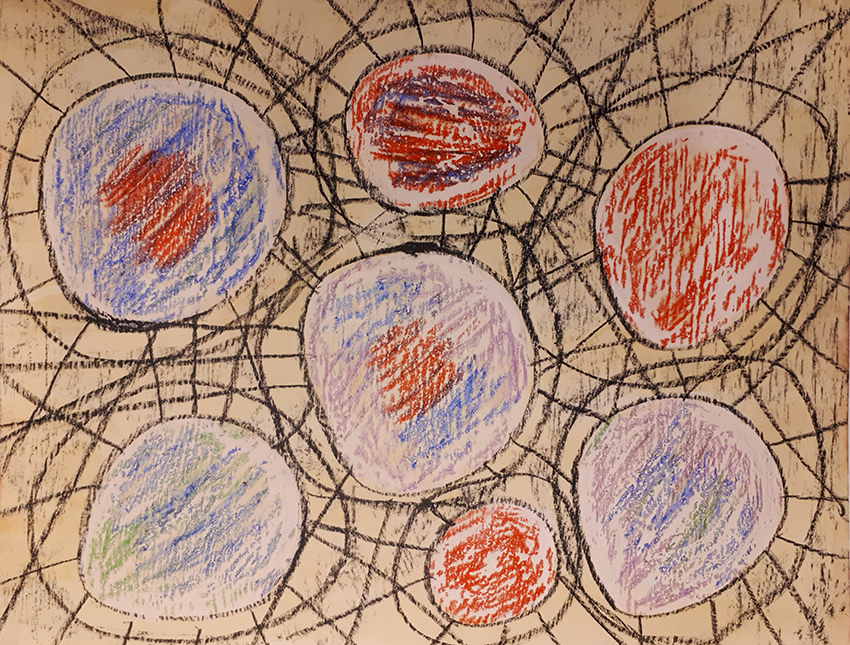
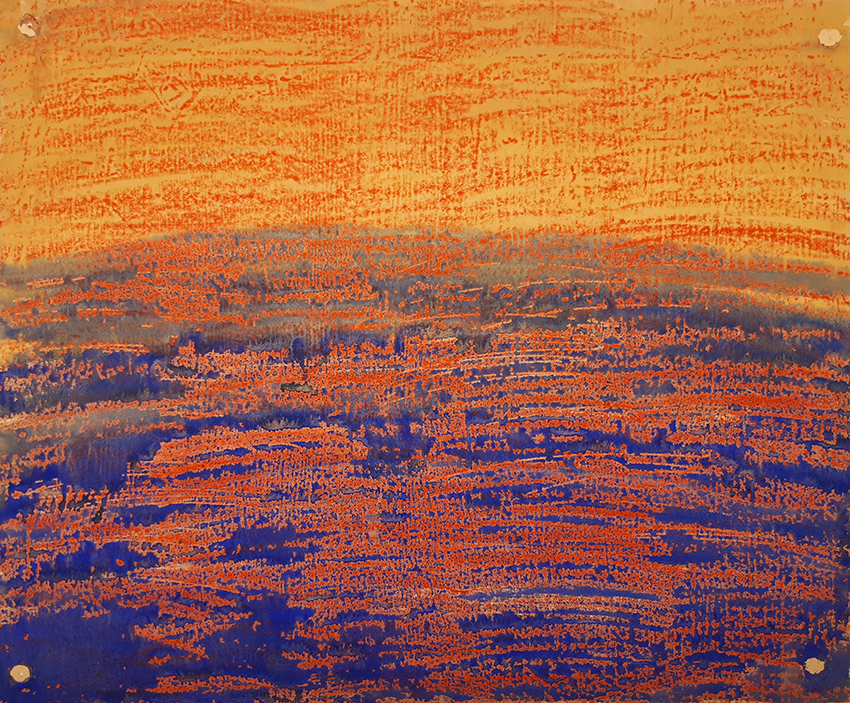

Patterns and Textures by Joan Wisdom
Edward Adamson issued the patients with basic materials and paper to work on. Much of the work is done on wall paper lining paper which is a standard 22 inches wide and was cut into sheets of approximately 22 x 16 inches (56 x 42 cm), which were then pinned to a board to avoid the paper buckling when wet with paint. In Joan’s case It is only 'The Institutionalized Patient' and her earliest work in the collection ‘Help’ that was done on larger sheets of 22 x 28.5 inches (57 x 72.4 cm).
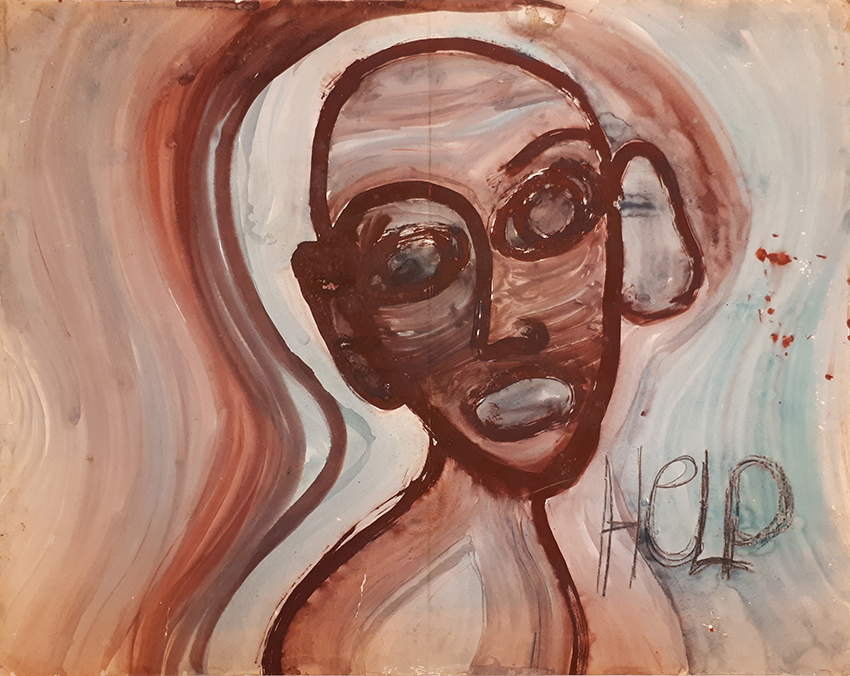
'Help' by Joan Wisdom
The paper has yellowed greatly with age and in some cases is in a fragile condition. The patients were given two paint brushes; a thick and fine version and what I am almost certain is poster paint/Gouache; I can tell this as poster paint/Gouache dries with a slightly grainy texture and can be used watered down to varying degrees from watercolours to impasto. There is also evidence that chalk or soft pastels were available along with wax crayons or oil pastels and pencils – I would err on wax crayons looking at the thickness and texture of the line, way that the paint sits around the line when it is painted over and how it feels to the touch. Also, considering what would have been available at the time on a limited budget, lining paper, poster paints and wax crayons would have been an obvious choice. I have also done some exercises in reproducing similar work in Joan’s style and have managed to attain very similar results.
Z.H.34.57.96.D

Z.H.34.57.96.D by Joan Wisdom
I have not been able at this point in time to trace any record of Joan Wisdom through the Surrey Record Office or The Adamson Collection Trust and Netherne medical records are not available for public viewing, so the only way that I can understand her life in any way is to look for clues in her work.
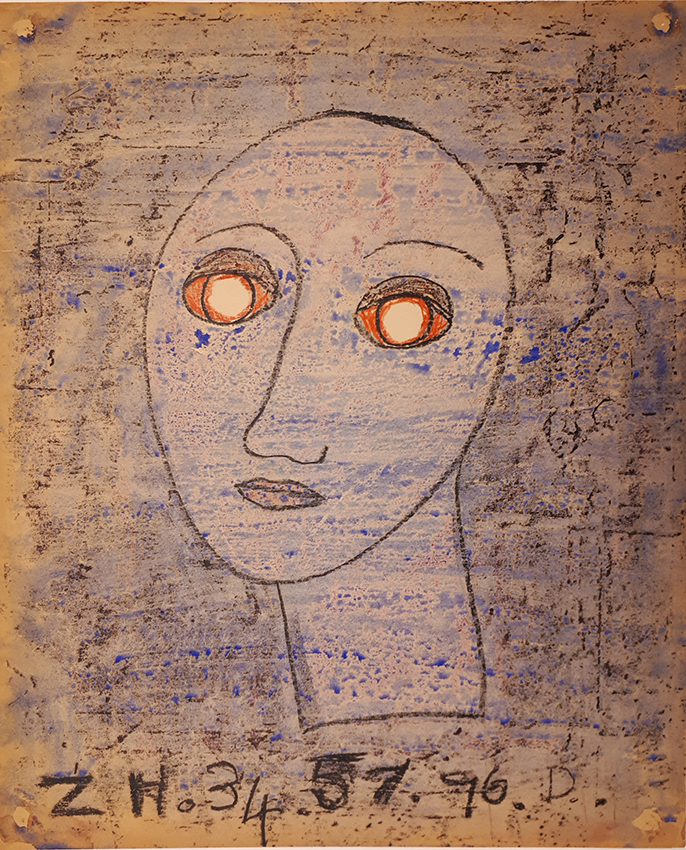

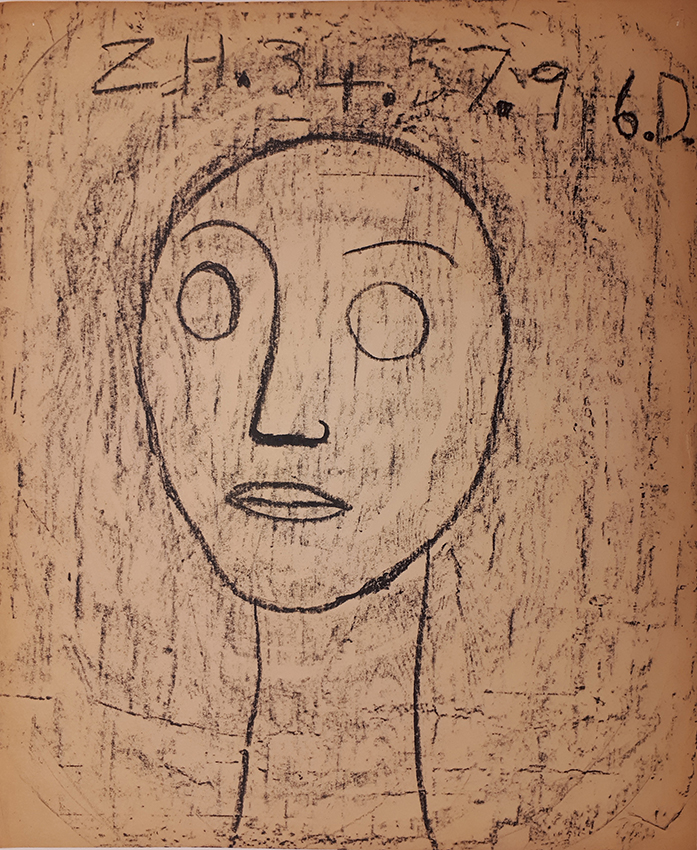
Z.H.34.57.96.D - Three Self Portrait Paintings by Joan Wisdom
Z.H.34.57.96.D I
can only assume is Joan’s hospital number which is very much like a prison
number, and indeed she does refer to the word inmate rather than patient in one of
her works. I do not know why she was committed to Netherne Mental Institution,
but it is important to remember that this is a different era that we find
ourselves in now, and many of the reasons for being admitted as a patient would
seem unjust or even absurd by our current social viewpoint. Unwed mothers, depression and
various mental health conditions would have all been committed to the same
environment and some subjected to treatments of the day which included surgical
solutions such as lobotomies, ECT (Electro-convulsive therapy) and notably from
the 1950’s new drugs that being introduced onto the market to treat such
conditions, some of which were not even diagnosed or given a name at the time.
It is well known that many of the patients attended classes with shaven heads
following surgery, and I suggest that this is reflected in many of Joan’s
paintings.
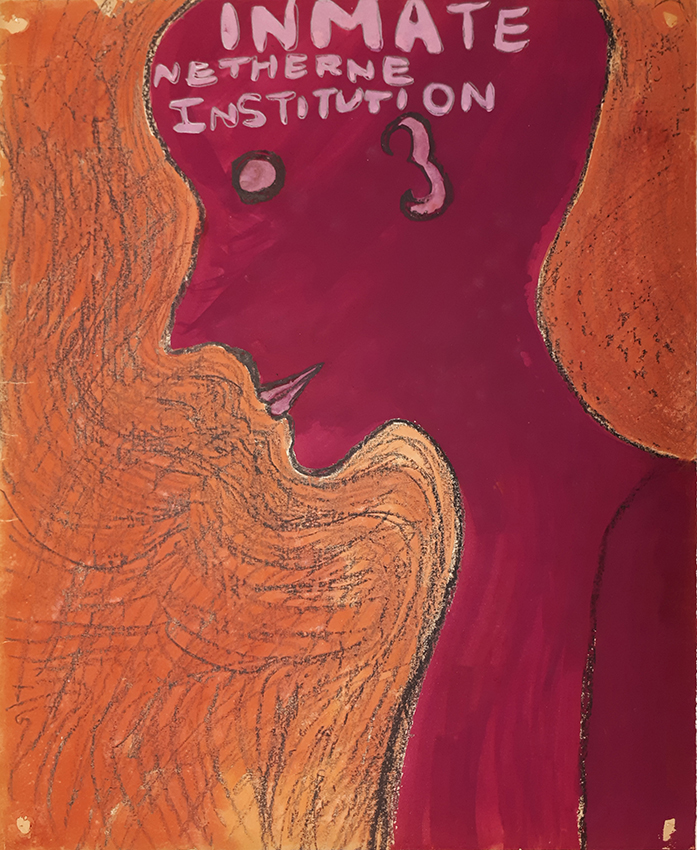
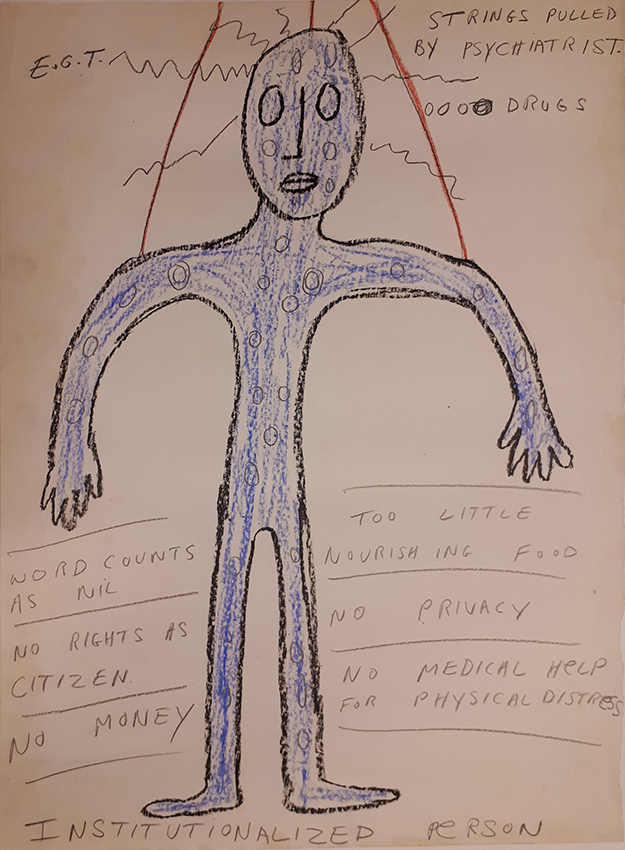
'Inmate Netherne Institution' and 'Institutionalized Patient'
Joan often wrote on her drawings which give us a good idea for her grievances. She also employed a few graphic vehicles to explain her picture further. This is evident when she depicts the writing in the head, strings attached to the patient's arms and the wavy lines indicating the electricity. In the 'Institutionalized Patient' the writing also itemizes 'OOOO Drugs' inferring to the 'O's' that are located all over the body.Having referred to the back of each painting I have also been able to put them into date order, compilations of which can be found as a separate blog page.

It appears that there is one example of her
work from December 1963 and two examples of her work form March 1964, the
remaining 54 examples are all from a single period that covers the whole of March 1967. Considering the
confidence
and competence
of her work, I am surprised that there is not more works by
Joan as was very prolific artist, on some days producing up to 12 drawings and paintings in a day. It
is possible that other examples of her work may have been disposed of when Netherne was
closed along with the rest of the bulk of the original collection. Maybe she did not attend
the art studio very often or was only at Netherne intermittently? According to Wellcome’s list of artists
there is no indication of when she was there aside from the dates on the back
of the drawings. All the other artists in the collection have an approximate date
by their name to indicate when they were resident at Netherne, all the artists
that is, except Joan Wisdom.
Alongside sorting the artwork into date order, I have also re categorized them in to themes to easily compare similarities in technique and subject matter, and to see when she painted one theme in relation to another. I think that her main focus fell into just a few distinct categories, with just a few falling across two of the six categories: Faces, Flowers, Cats, Patterns, Snowflakes and Fish.
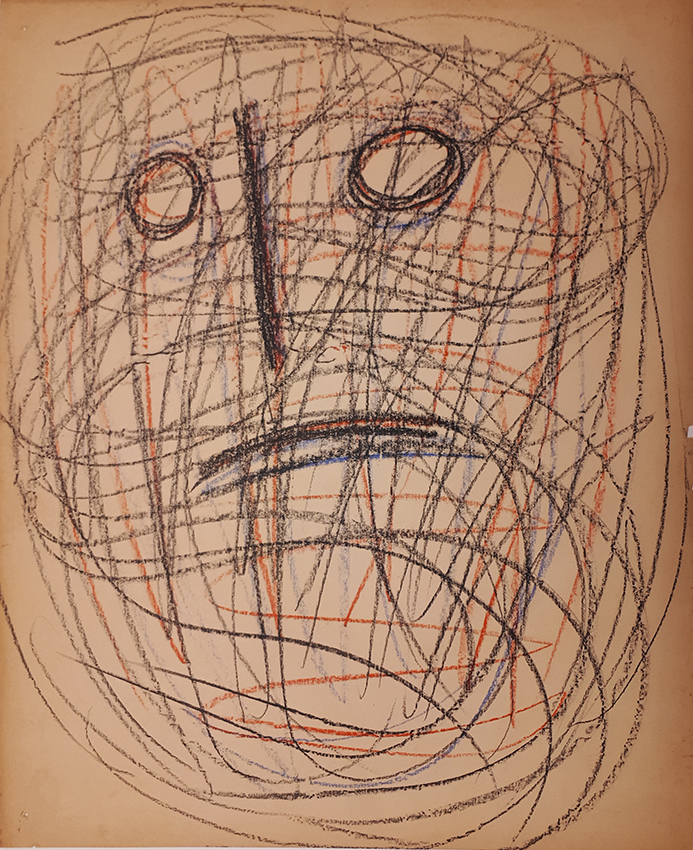
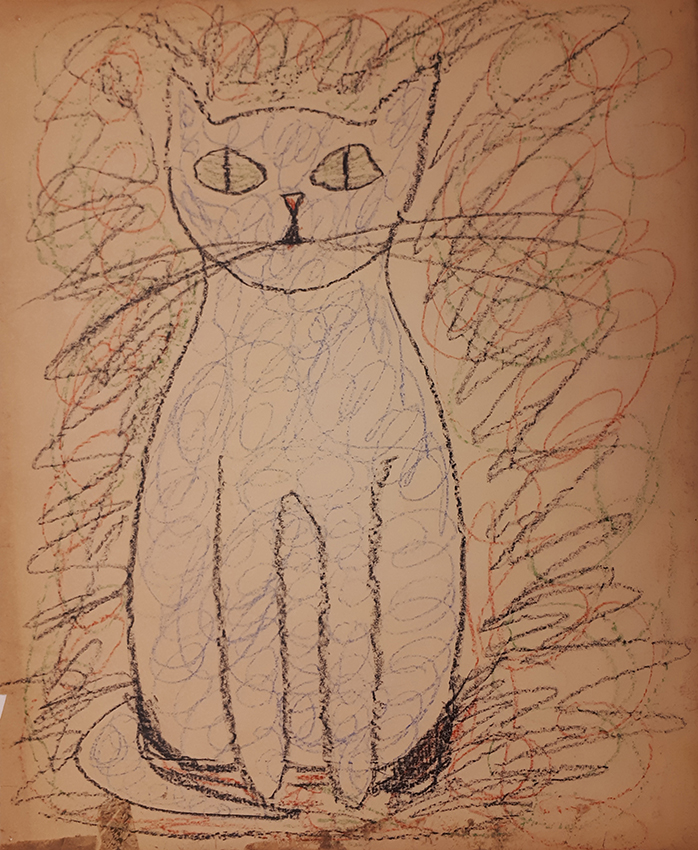
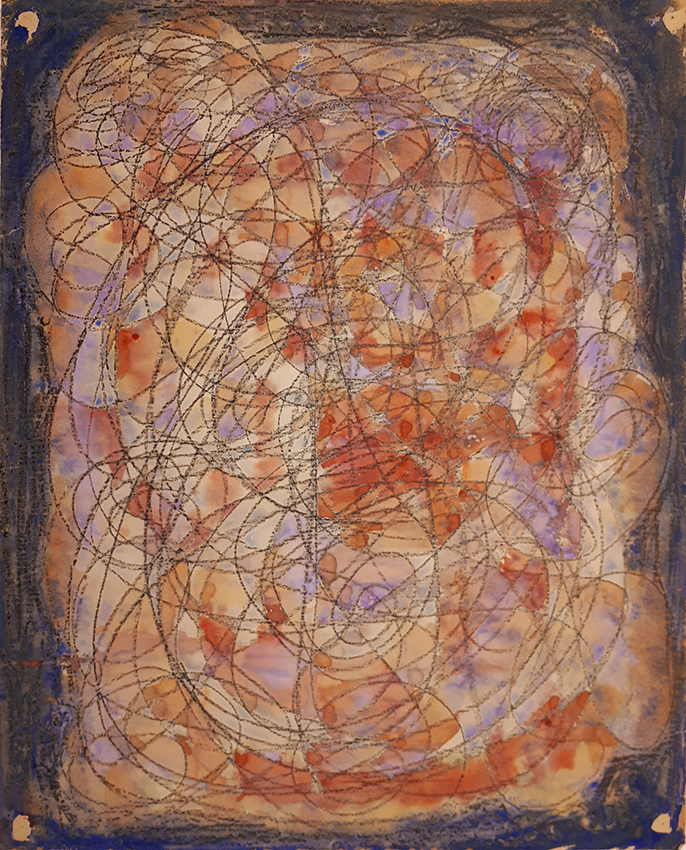
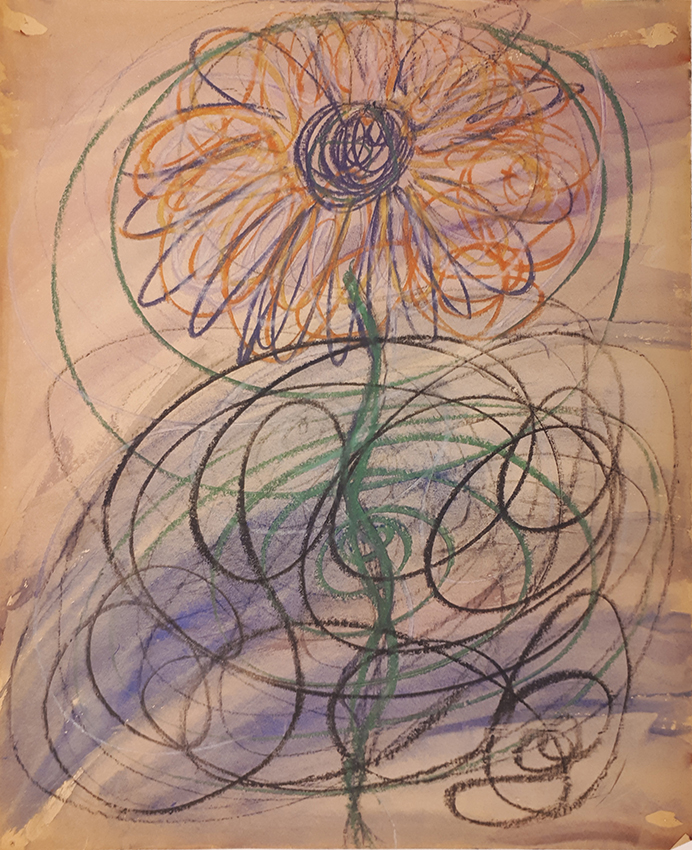
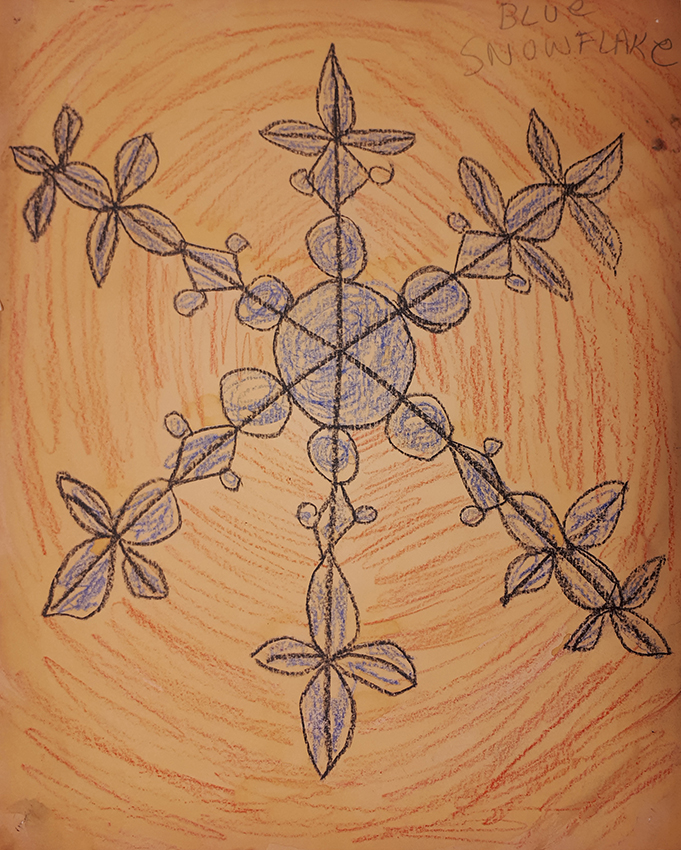
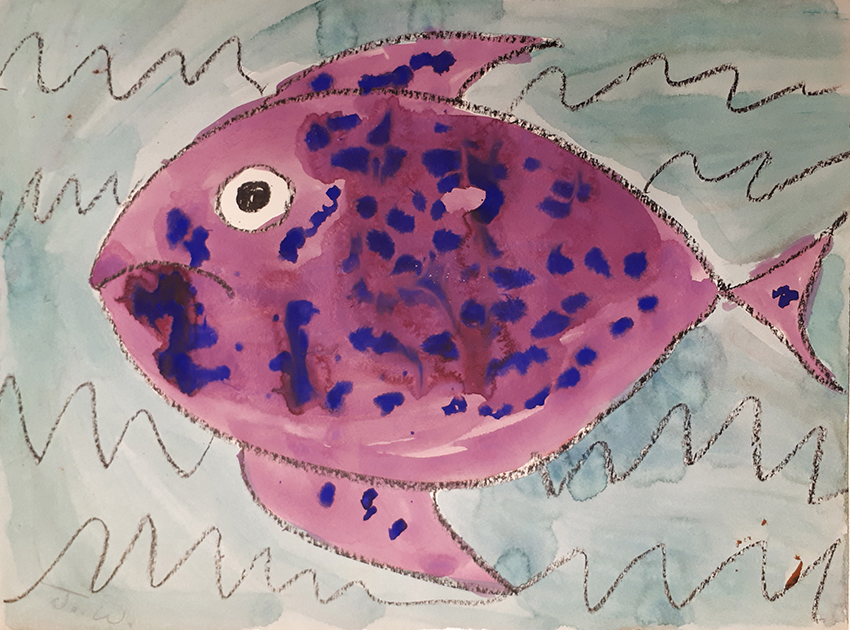
Faces, Flowers, Cats, Patterns, Snowflakes and Fish by Joan Wisdom
I wanted to understand Joan and a bit of what her life might have been like, so the following is really educated conjecture derived from information that I have drawn from looking at her work. Her work is honest forthright and frank; it is therefore testament to the way that Edward Adamson ran the art studio at Netherne, giving the patients the space and freedom to say whatever they wanted in their artwork without fear of any repercussions from the doctors. Joan used her voice in her work, often inscribing the feelings and sufferings of the subject of her paintings, and it is these words that I can infer aspects of her life.
Faces
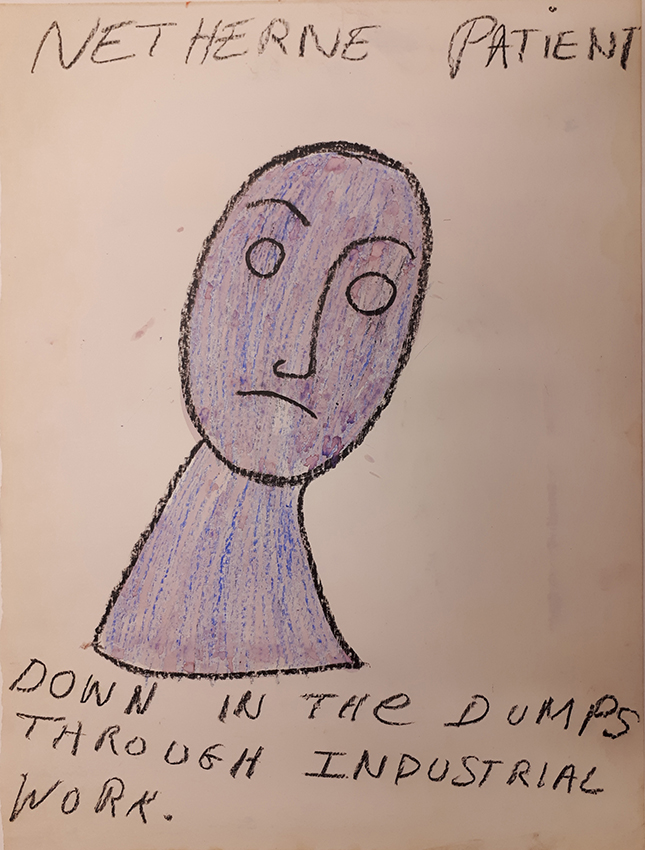
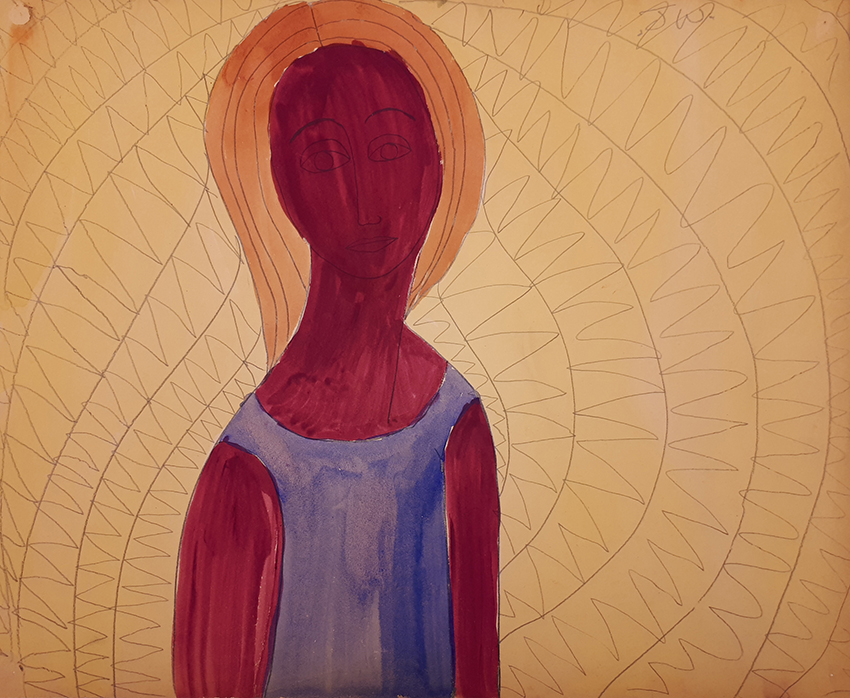

'Nerthere Patient', 'Self Portrait' and 'The Silent Scream'
I see Joan as a fragile and tortured soul, she feels controlled and trapped by the phychatric doctors who have inflicted ECT (Electro-convulsive therapy) on her and filled her with drugs. I think that many of the faces and portrayals of people are actually self-portraits, detailing her emotions and reactions to her treatment. If they are not actual self-portraits they are almost certainly reflections of her feelings of what was going on around her. Patients were given work at Netherne, there was a printing department, probably cleaning and laundry tasks. The patients lived in dormitories and were not allowed any personal possessions. Joan mentions the lack of nourishing food, no privacy, no rights as a citizen, that she as a patient was not listened to, had no money, and no medical help for her physical distress. Her work talks of being made to do industrial work and the fear that she has of the Psychiatric Doctors and her terror of the treatment that they inflicted on her.
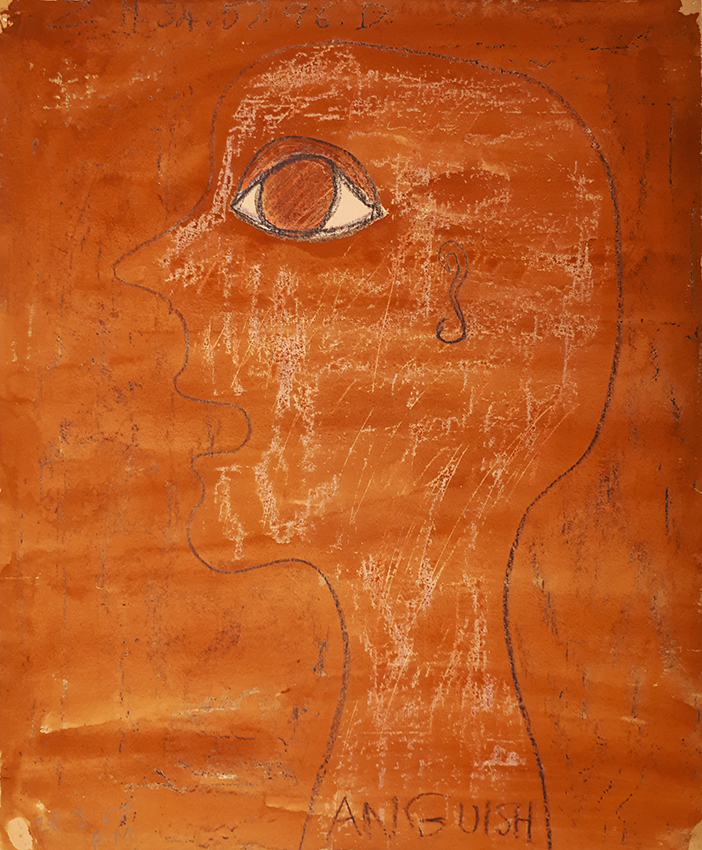
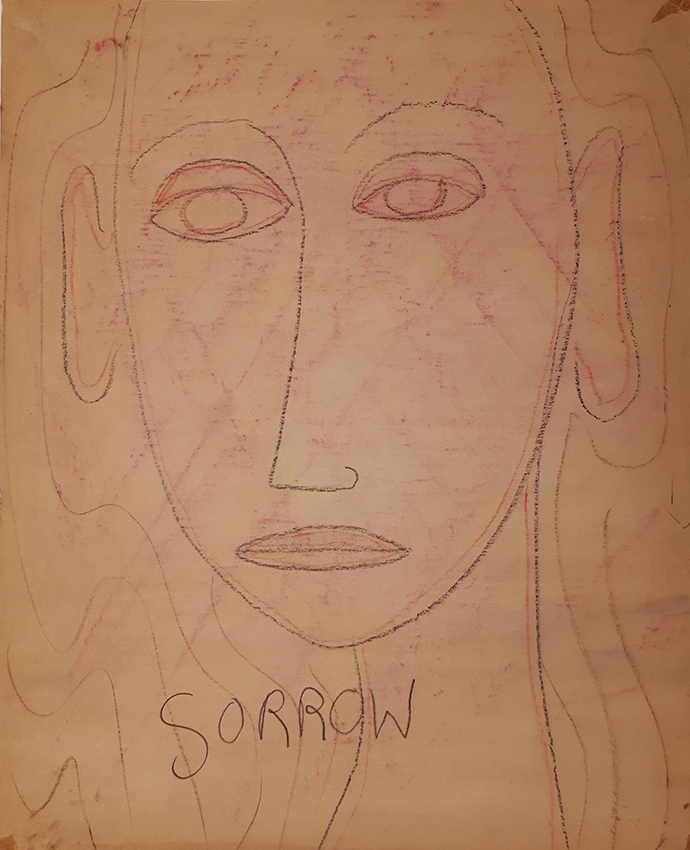
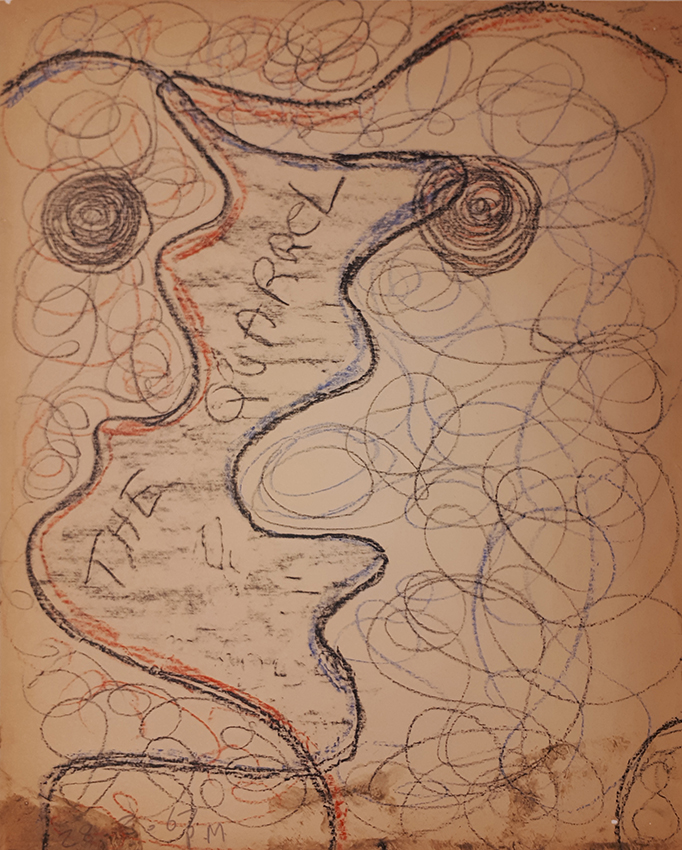
'Anguish', 'Sorrow' and 'The Quarrel'
The ECT was probably
painful and very distressing, and the experimentation, as it would have been in
the early days of the use of psychiatric drugs, new drugs that were just being introduced
into mainstream medicine at the time. All the emotions that she paints are sad;
Sorrow, Grief, Misery, Fear, Anguish and ‘Down in the Dumps’ and relate a distressing event in 'The Quarrel'. The colours
that she uses reflect these moods, there is no shouting in her work, just
silent screams and generally muted colours. Even when she does use colour she selects the tone and opaqueness that suits the mood she is representing.
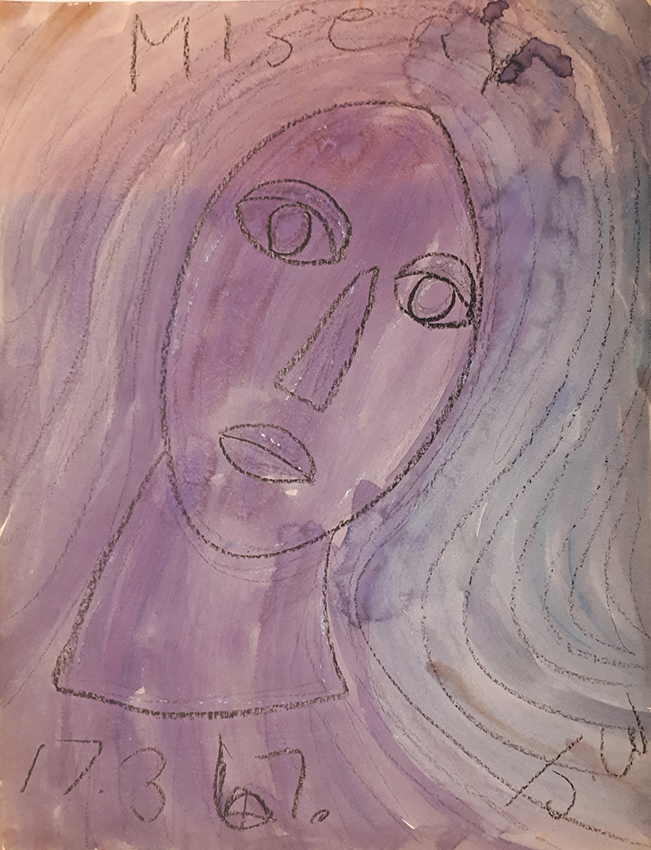
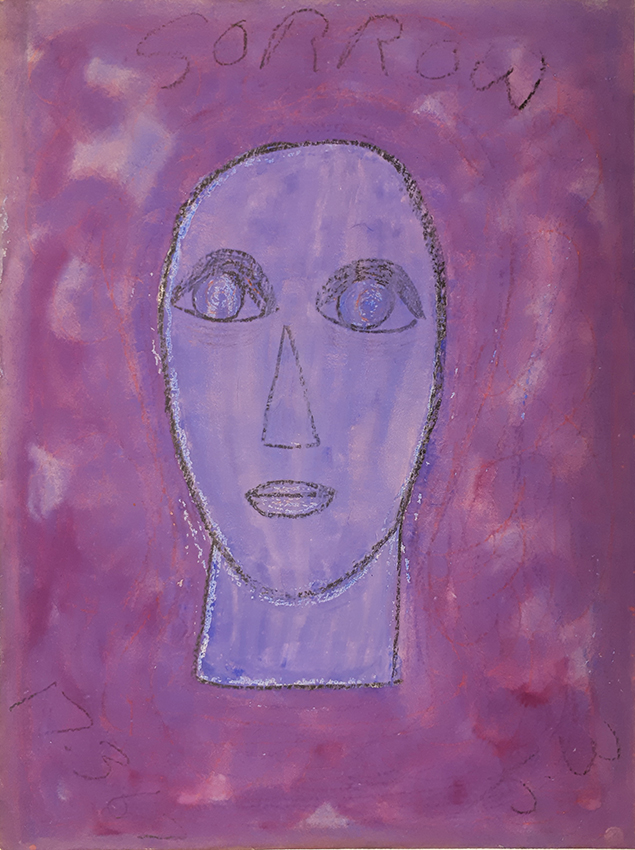
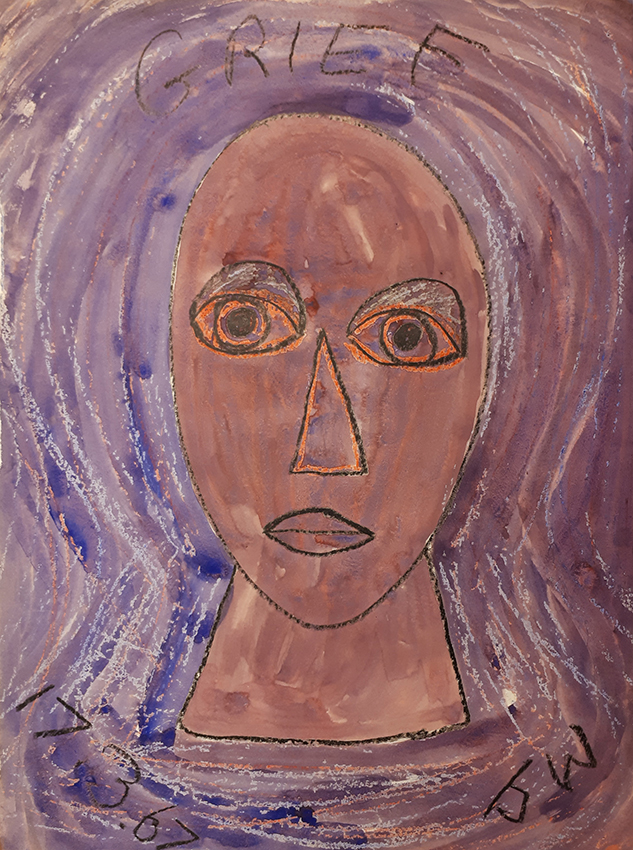
'Misery,' 'Sorrow' and 'Grief'
To draw in the style that Joan does require a confidence, forethought, detailed observation and planning. She creates her faces and figures with a single line, occasionally she will scribble out a line if it is wrong, determinedly letting the viewer know which line to read when looking at the work. The faces have simple delicate features; a simple line that forms the eyebrow and on one side drops down to form the nose, and the mouth is either a single line or a set of three lines that close at each end to form the lips. Occasionally she will include ears, and only in the calmer portraits does she depict herself with hair. The eyes have two main forms, one that includes the eye, iris/pupil and upper eyelid and the other, a simple circle that depicts the blank stare of the medicated or treated patient, sometimes the eyes are coloured in indicating vacancy, sometimes the eyes are depicted as crying in floods of petal tears.


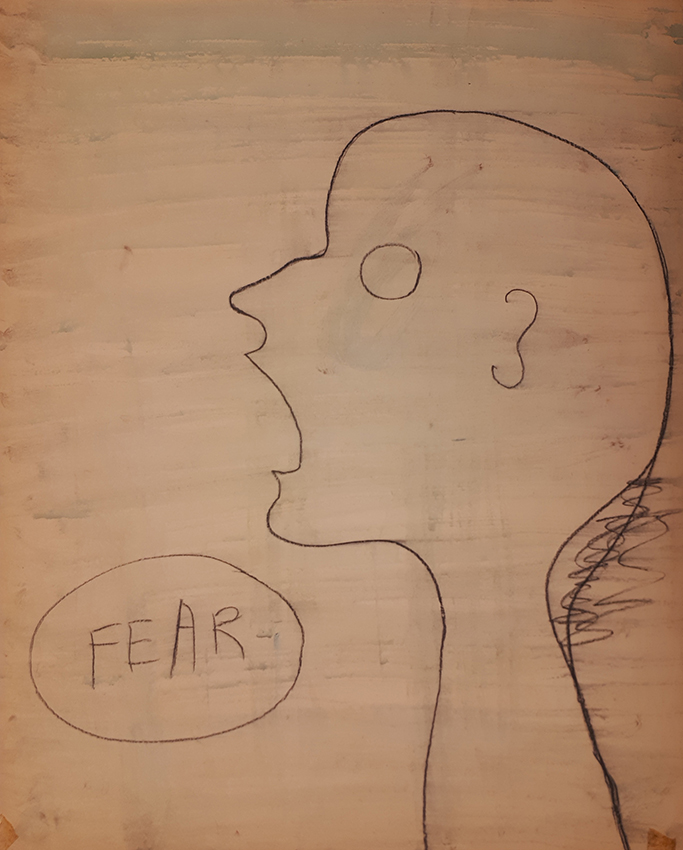
'Floods of Tears', 'Crying' and 'Fear'
The faces are drawn either square on or in profile, never a three quarter view, sometimes painted, and sometimes left just as line. In all her portrait paintings she manages to capture very succinctly the emotion that she is expressing, the combination of colours, texture, mark making and expression all combining to share that emotion with the viewer on so many levels.
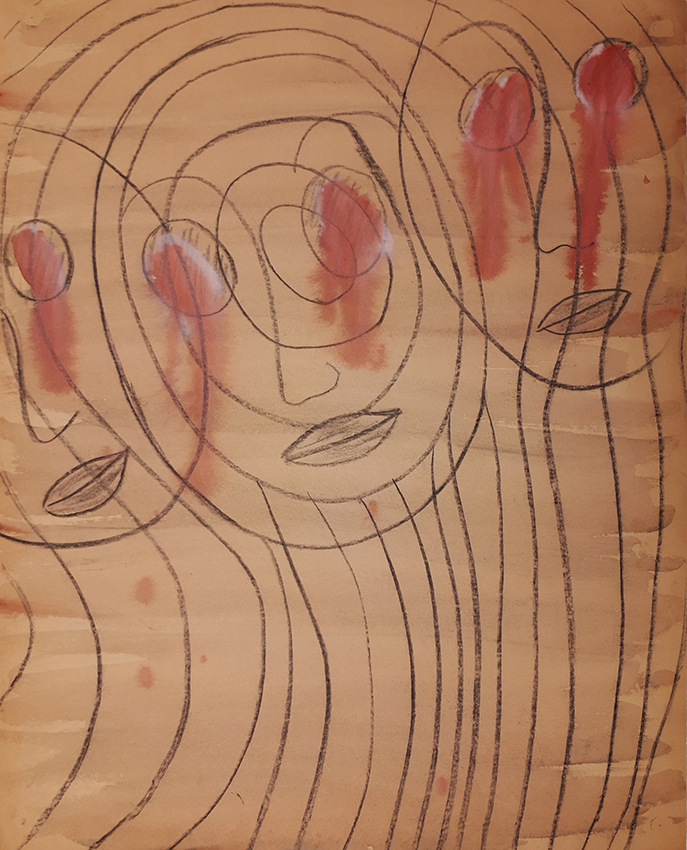
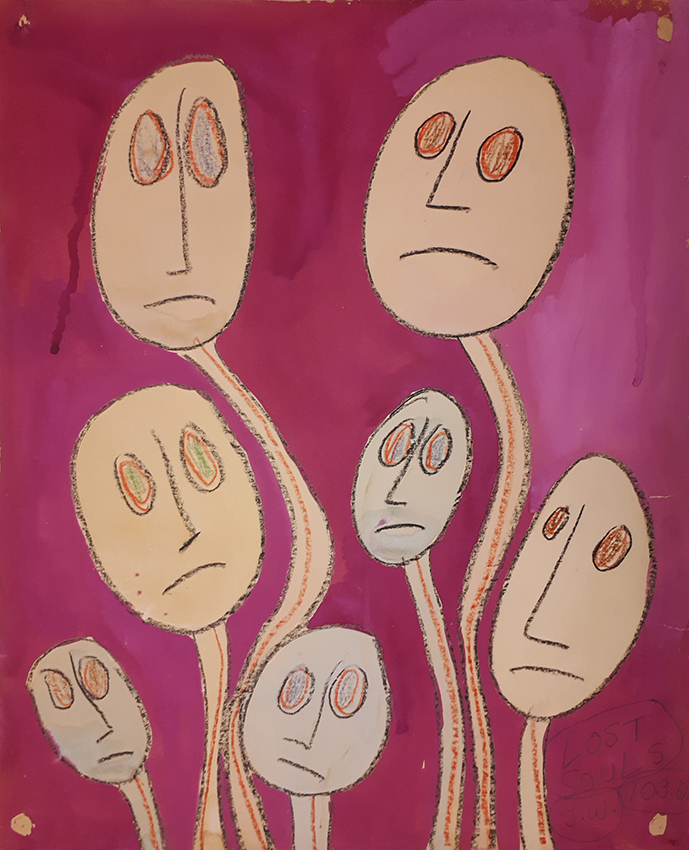

'Crying Eyes', The Lost Souls' and 'Boxed People'
She is also very aware that she is not alone in her situation, she is very vocal about the fact that other patients around her are also subject to the same horrific treatment, most evident in the ‘Lost Souls’ painting with the blank bald faces with vacant eyes and ‘boxed people’ where she depicts the sad faces separated into rectangular boxed bordered by swirly shading, reminiscent possibly of the dormitory sleeping arrangements; rows of beds aligned in a room with no privacy separated only by an aisle.
Cats
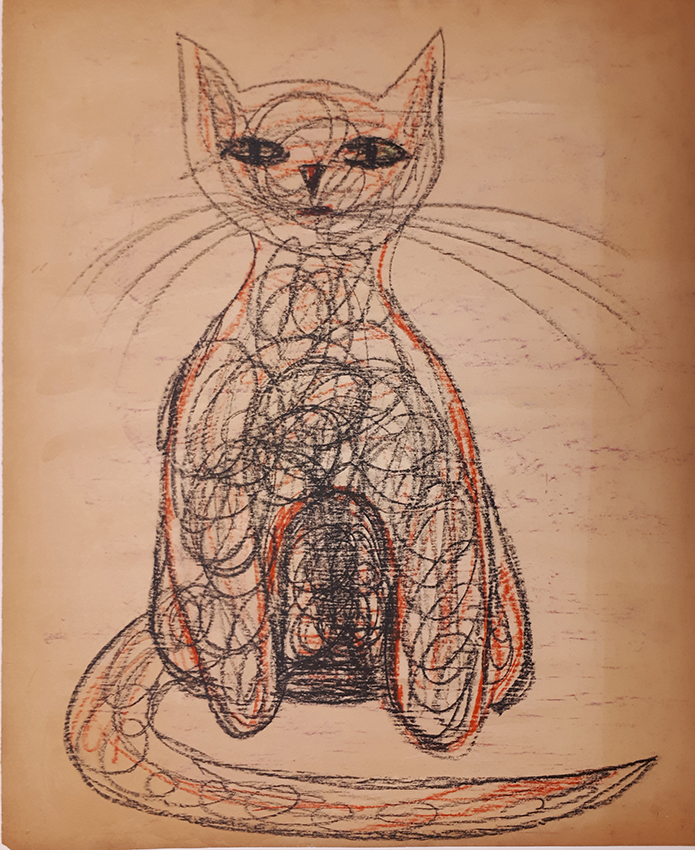
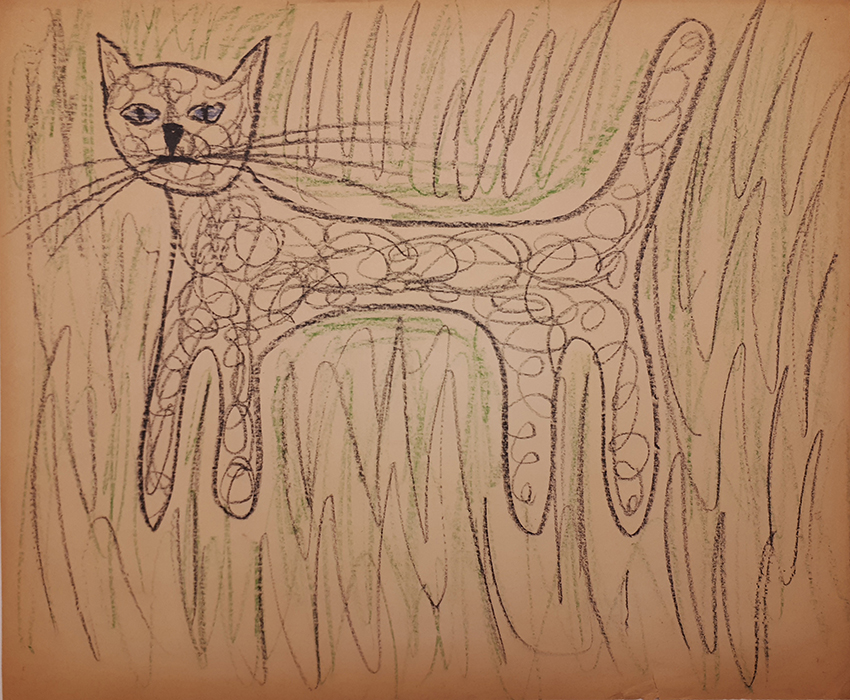
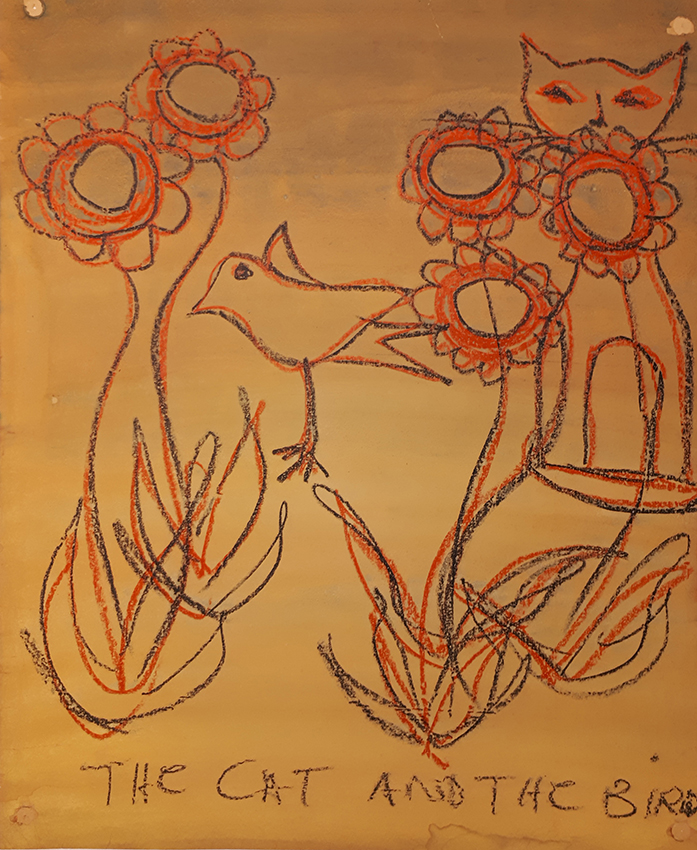
Cat Seated', Cat Standing in the Grass' and 'The Cat and the Bird'
I feel that Joan, despite her treatment and deep depression at her circumstances and situation was a sensitive soul and in touch with her surroundings. Netherne Hospital was a collection of buildings situated in beautiful English Surrey countryside, there were no fences or walls containing the patients who were free to wander the grounds. In fact the surrounding path was built with just a slightly raised edge that would enable those with impaired vision to use a stick to guide them around the edge. She must have been very fond of the cats that were resident at Netherne, she did a number of works depicting them, sometimes in the grass, and one, really the only scene that we have of her work, with the cat watching the bird in the flowers in the gardens. The cats are drawn with real sensitivity, I think that Joan found a comfort and companion in the cats, they would have been her friends in an otherwise fairly loveless existance.
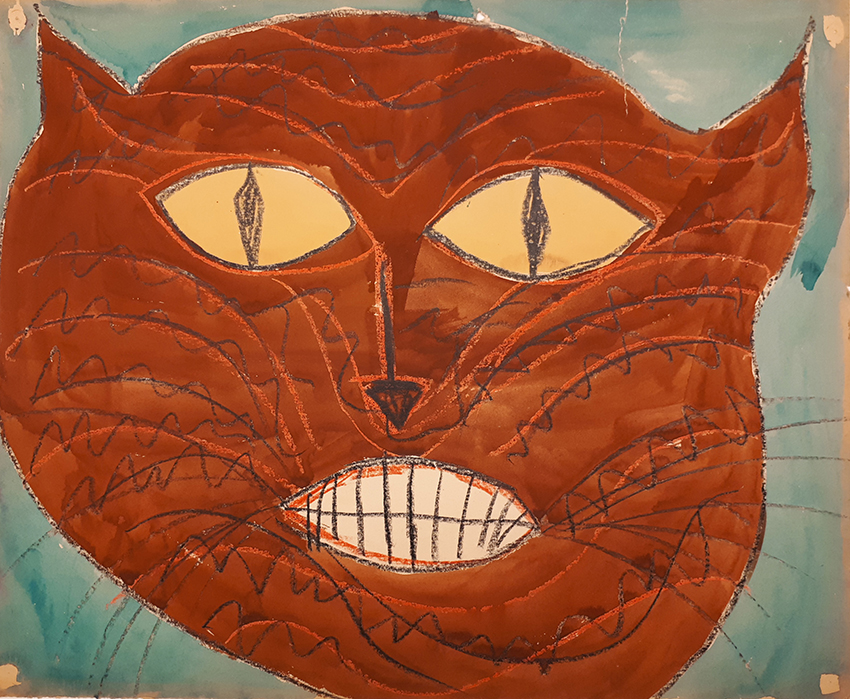
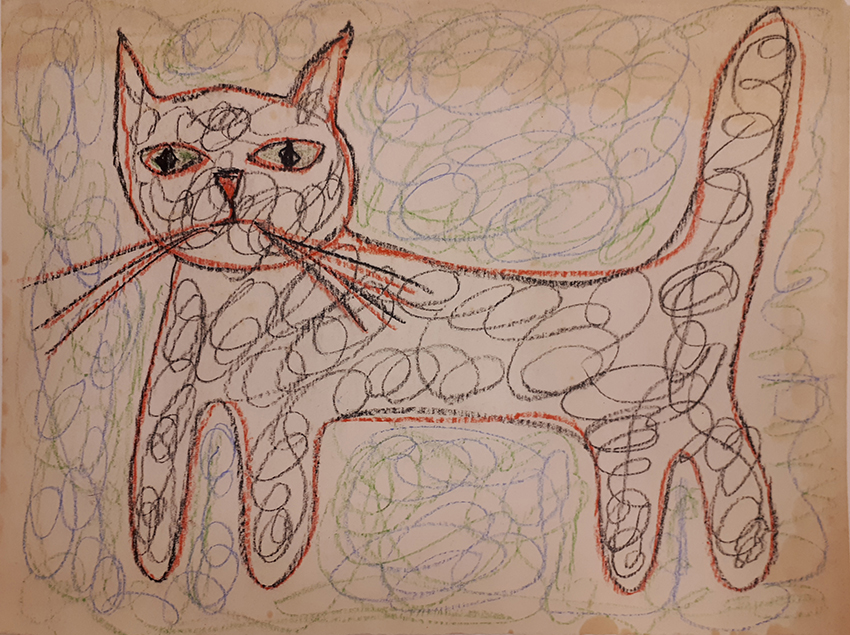
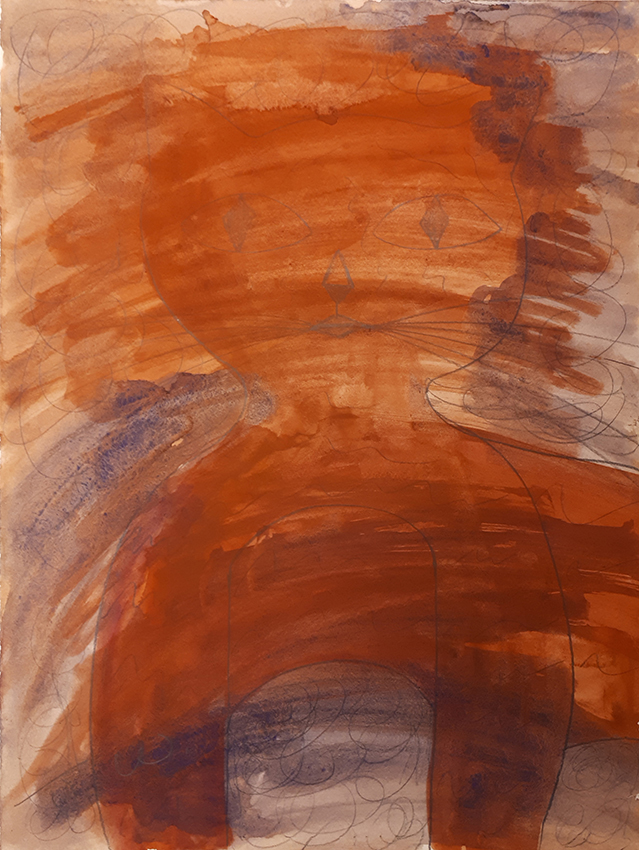
'Fierce Cat', 'Standing Cat' and 'Sumdged Cat'
Flowers
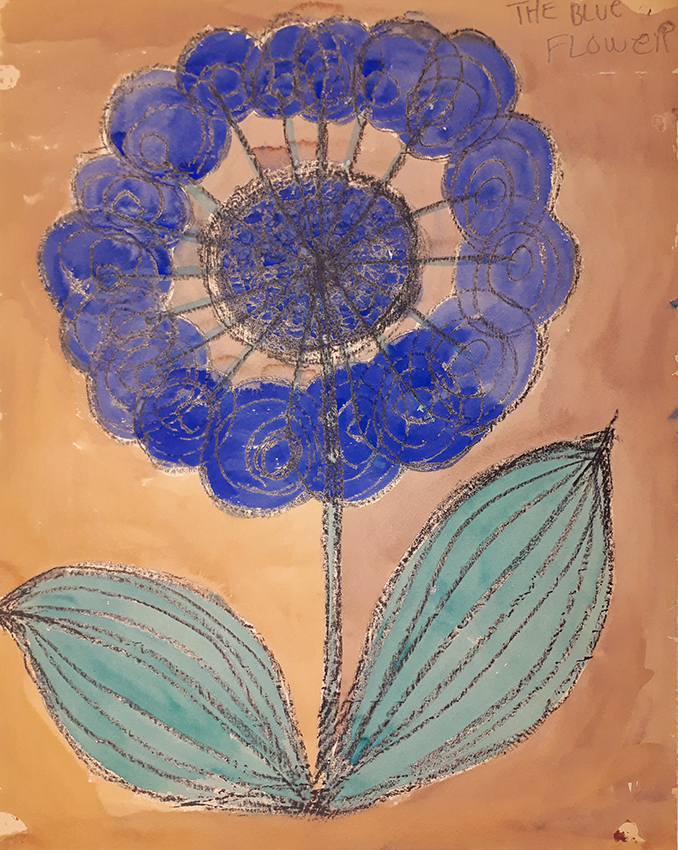
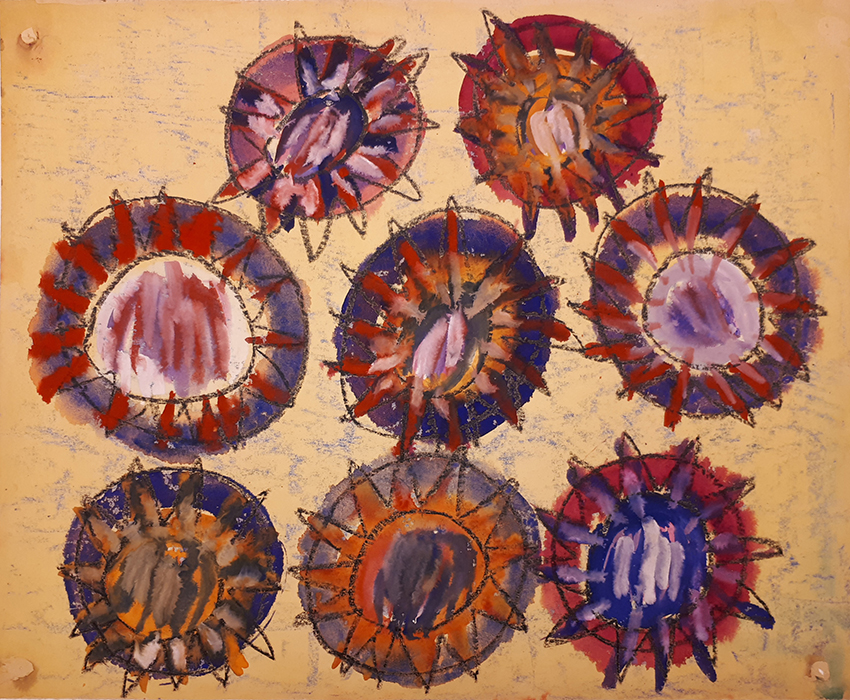
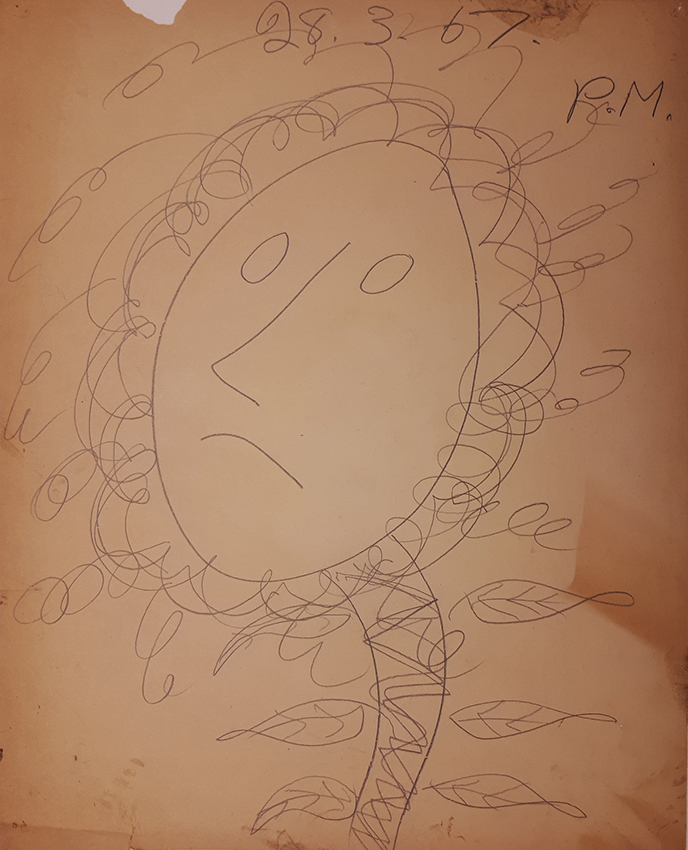
She also was fond of drawing the flowers, seeing beauty in the nature around her. Although she actually only drew a few actual flowers with stems and leaves, she would I feel more often abstract the shapes into patterns and groups, exploring the shapes and textures of the physical object and combining it with the textures that she could create with her paint and crayons. The colours she uses reflect the bright colours that are found in nature, and fortunately for us these colours are well preserved in the artwork in the collection. The flowers hint at brighter almost happier side to Joan, although even the flowers are sad at times.
Fish

There is one painting of a fish that stands out because of its uniqueness of subject matter, the fish is bold and bright purple and blue, yet it too has a sad face; I wonder if this was inspired by a fish in a tank that Joan related to as it was trapped in its environment unable to escape.
Snowflakes


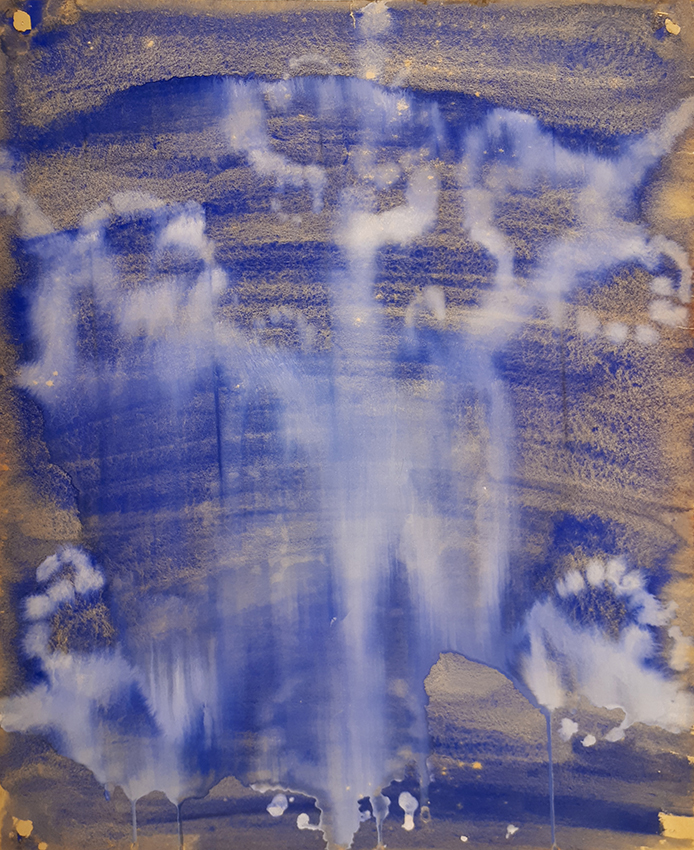
'Snowing', 'Blue Snowflake' and 'Melting Snowflake'
This relationship that Joan had with nature and her surroundings is also evident in the snowflake paintings. When checking the backs of the paintings for the dates as I suspected the snowflake paintings were all painted within a short space of time on the 16th and the 20th March 1967. I then researched what the weather was like for that period of time in the location, and according to Met office records 0.784 for the month of March 1967 “Snow and showers were observed in Scotland on most days during the first half of the month and also during the last week. They fell in England and Wales mainly around the 11th and between the 26th and 31st when some of the higher ground became snow covered for a time.” The ground may or may not have been snow covered at the time of painting, but I am sure Joan would have experienced the snowfall in the preceding days and that it certainly attracted her attention and fascination. She studied the individual snowflake, the experience of snowfall and also reflected the delicate fragile nature of the snowflake as it melts in her use of paint as she allowed the white of the snow to bleed into the blue background, maybe reflecting the bright clear blue skies that are often seen following a snow fall.




'Sumdged Cat', 'Misery,' 'Sorrow' and 'Grief'
Considering the immediacy of Joan’s reaction to the weather
in painting snowflakes, I find another possible connection or story in her
drawings; on the 16th March she paints a very smudged version of a
cat. All the other cat drawings are complete either fully painted or scribbled
in her familiar circular pattern, maybe representing fur, this one is drawn in
a pencil line over a big smudge of a background. The next day on the 17th
March Joan paints ‘Sorrow’, ’Misery’ and ‘Grief’, I wonder if one of the cats
that she was so fond of had died? Did she deal with an event by out pouring her
feelings into her work?
Patterns


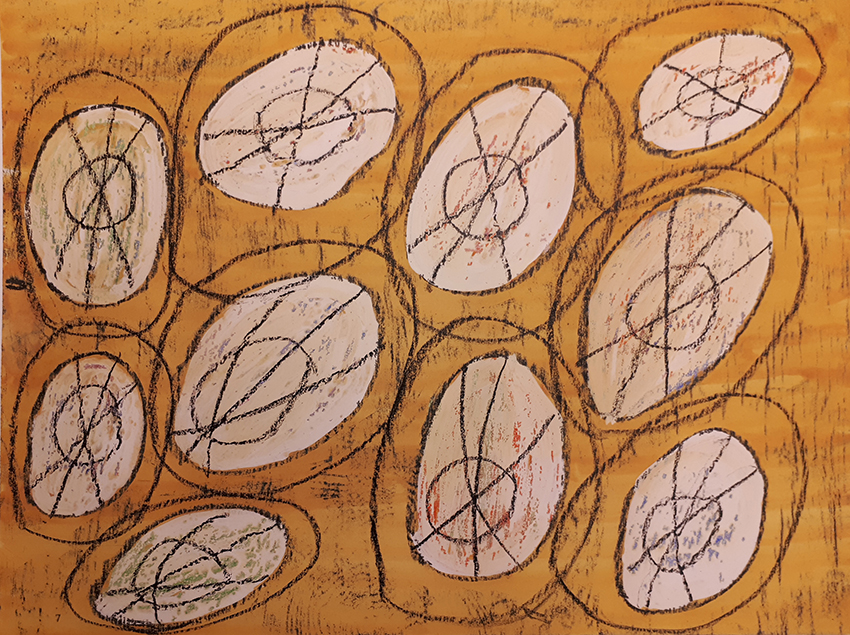
'Pattern of Flowers', 'Scribble in Brown' and 'Circle Pattern'
Joan also made a collection of patterns, utilizing flowers, her trademark scribble technique and repeating circles surrounded with colour, lines and texture.
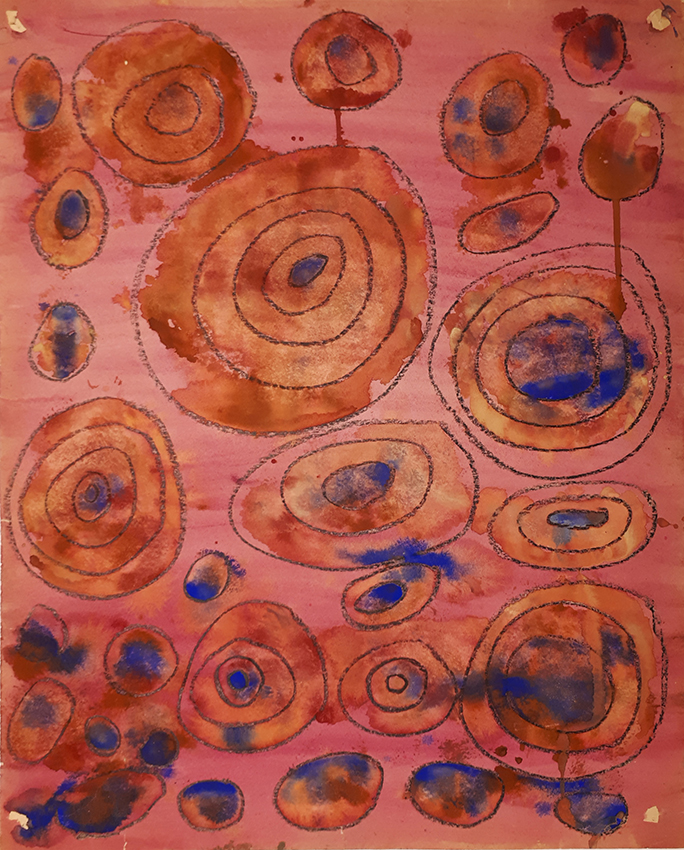
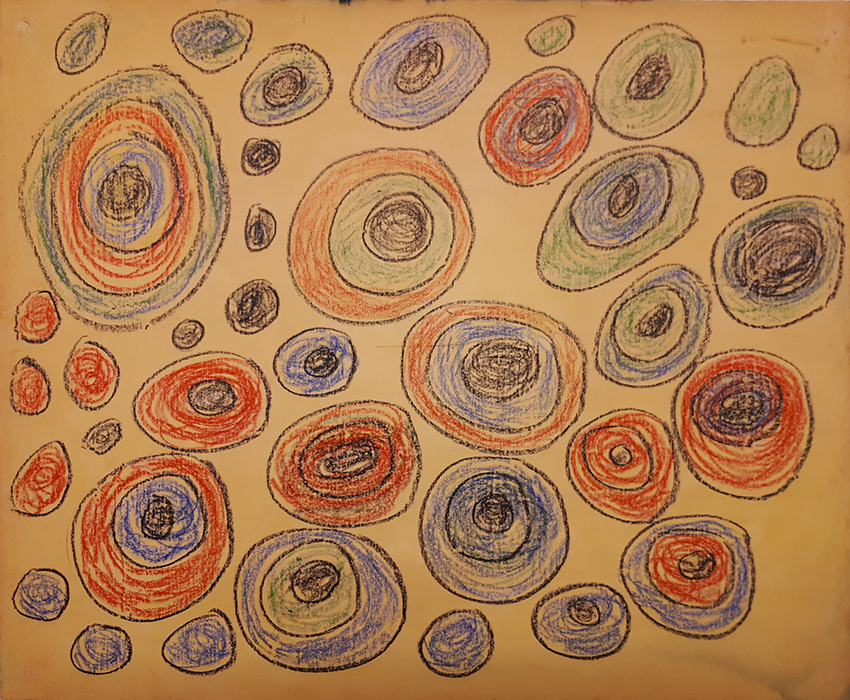

'Circles on Pink', 'Circles on Yellow' and 'Circle on Brown'
She often employed the use of circles, I wonder if this may have been, even possibly subconsciously, a response to the drugs that the patients were given; the circles representing the pills. Looking at her use of colours I also wonder how much she would have encountered the design of her age; her work certainly has reflections of sixties influenced shapes and colours.
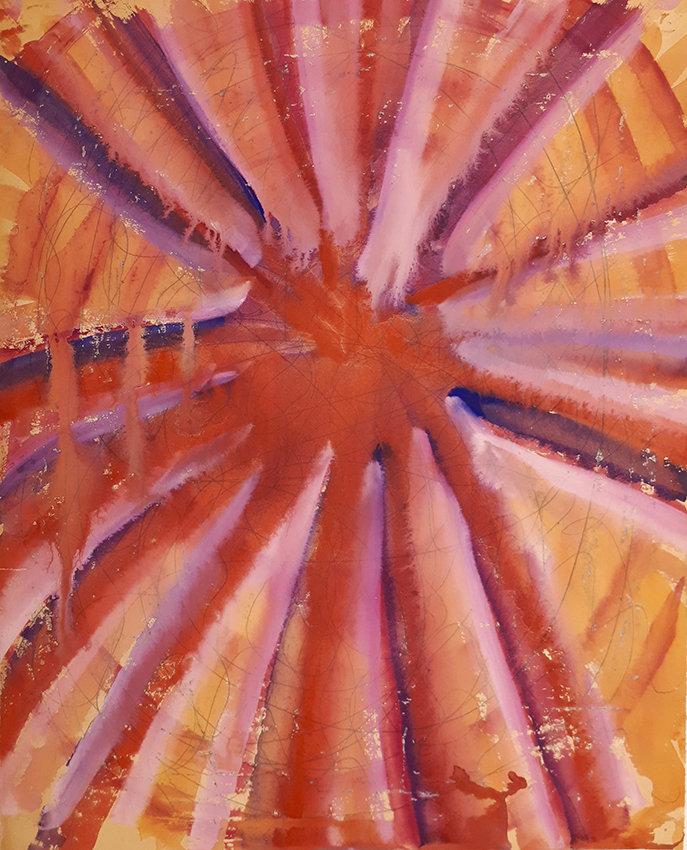
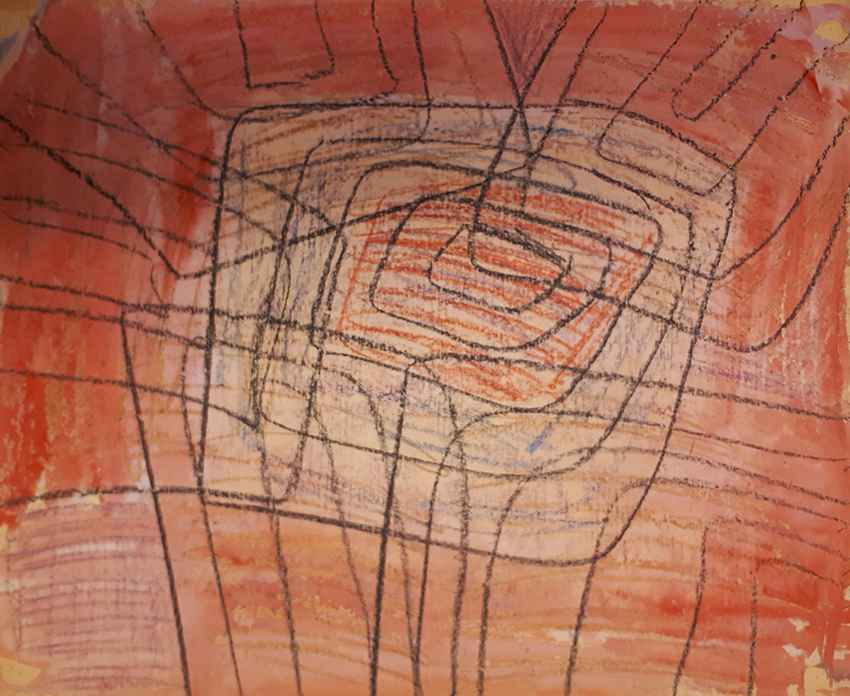

'Star', 'Squares' and 'Circles'
I often wonder how Joan felt about her work, did she look forward to the Art Classes? Did she go there with a particular project in mind or did she just work on the spur of the moment? Did she feel precious about her work, the example below; 'Pink Patterns' appears to have ended up on the floor and subsequently trodden on. Did Joan disregard this piece or was it finished and rescued by Adamson at the end of the session? In 'Paw Print' did she intend for the configuration of circles in the shape of a cats paw print or was it accidental?
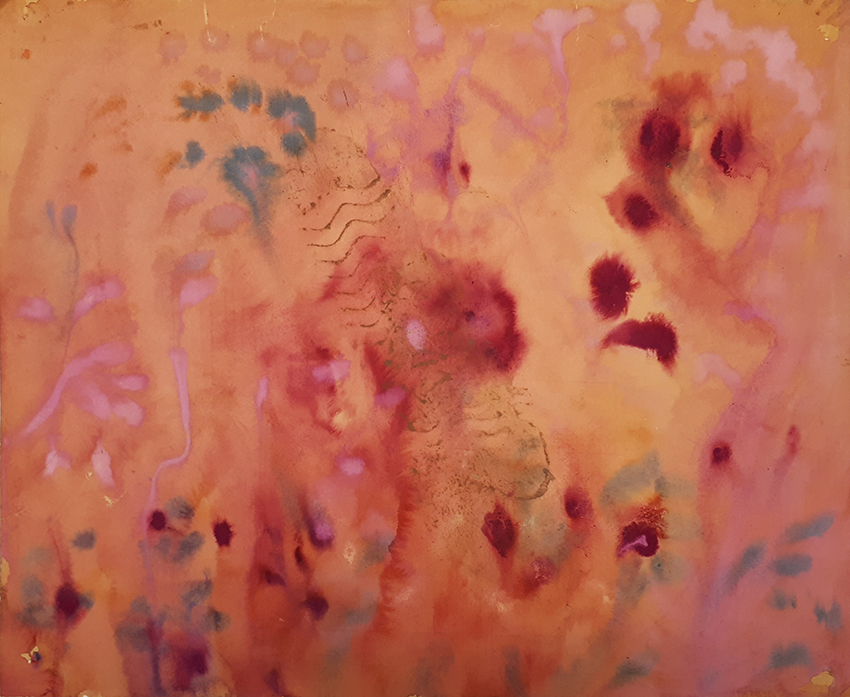
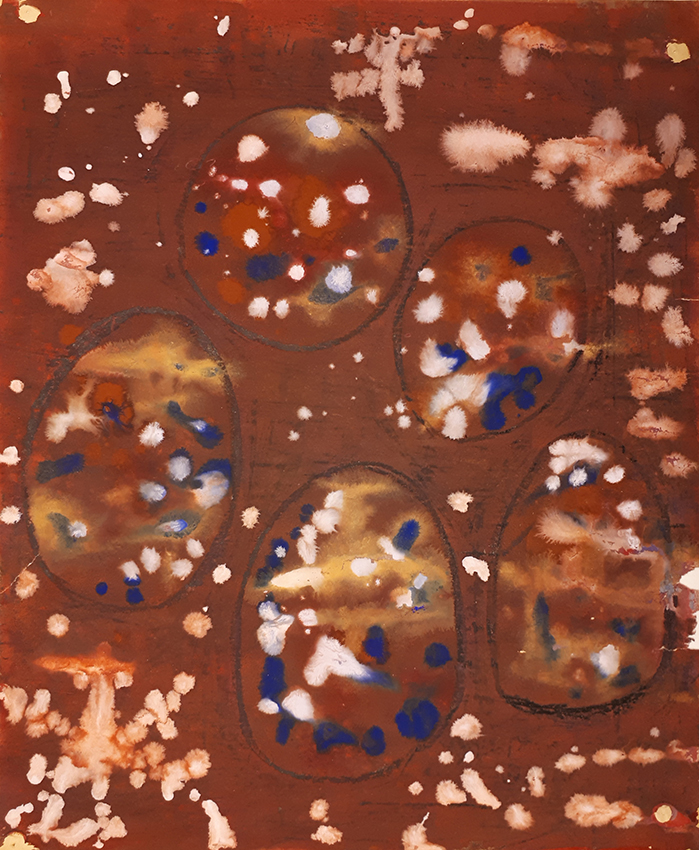
'Pink Patterns' and 'Paw Print'
Having studied Joan’s work I feel that I have grown a real affinity with her. The immense sadness and evidence of sheer terror that she experienced in the doctor’s effort to treat whatever condition that they deemed her to have appear to be a recipe for depression and mental health problems that would challenge any person sane or unwell. This small record of Joan’s life transcends her medical records and we as a viewer from a different era are privileged to have this brief look into her world.

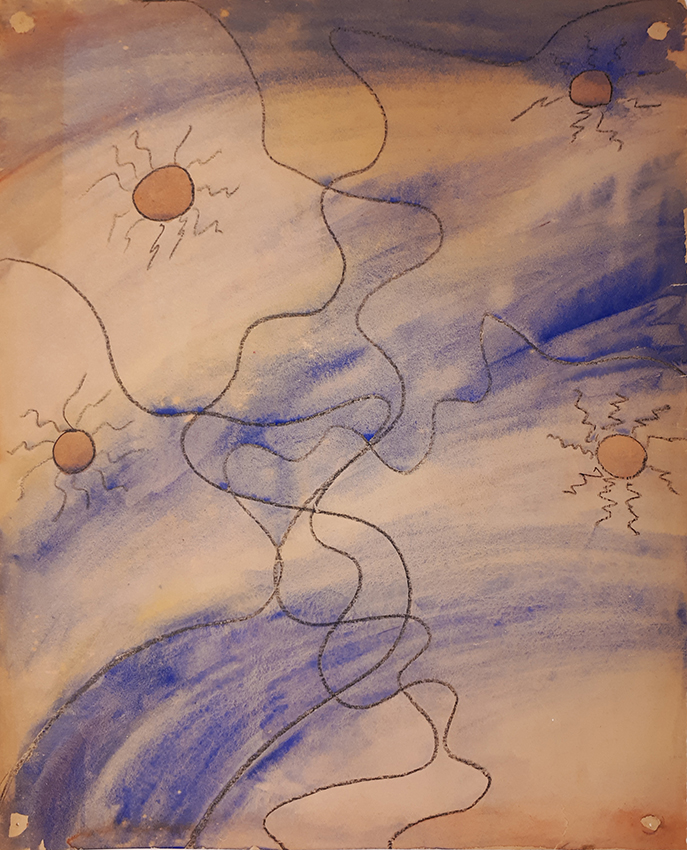
'Fear' and 'Crowded People'
August 2018
